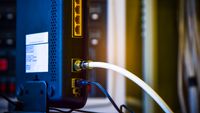How Do Fiber Optic & Cable Internet Connections Compare?
By NHTC

Whether you want to stream videos at home or connect with clients at the office, having a reliable internet connection is essential. While there are many ways to achieve this connection, most Americans rely either on fiber optic or cable technology. Although these services may seem similar at first glance, they feature many different capabilities that could improve or worsen your overall online experience. To help you better weigh your options, here is a quick comparison of fiber and cable internet services.
Cable vs. Fiber Internet Service
Design & Functionality
Cable internet relies on a coaxial cable that features a copper core, aluminum insulation, a copper shield, and a plastic exterior. These cables can transmit data to support both cable television and internet services. However, to maintain an online connection, users will need to use a modem.
 Fiber optic cables contain thin strands of plastic or glass that carry digital data via modulated light. These resources do not require a modem and are equipped to transmit data over longer distances than cable.
Fiber optic cables contain thin strands of plastic or glass that carry digital data via modulated light. These resources do not require a modem and are equipped to transmit data over longer distances than cable.
Speed
While cable-broadband internet services were once considered relatively fast, fiber connections significantly outperform these solutions.
Offering download and upload speeds measured in gigabits—a larger unit of measurement than cable’s megabits—fiber internet offers seamless performance whether you’re surfing websites, streaming videos, or playing online games. By comparison, cable download speeds top out at 1 Gbps and offer maximum upload speeds of 50 Mbps.
Reliability
Weather and temperature changes can interrupt the electrical flow of cable solutions, which, in turn, can increase latency. Fiber, however, does not transmit electricity and is, therefore, not susceptible to these service interruptions.
Cable is also a shared resource, which means you can experience a slower connection during peak usage times. Since fiber uses a dedicated line, you can count on continuous access to the internet without a decrease in speed.
Accessibility
Fiber is not as available throughout the country as cable is. As such, some consumers in rural areas may have trouble accessing high-speed capabilities.
Cost
When fiber was introduced, it was much more expensive than cable services. However, in recent years, expanding networks have made fiber more affordable. While it remains more costly than cable, the high speeds and dependability it offers can provide a considerable return on investment.
Dedicated to providing customers with state-of-the-art telecommunications, New Hope Telephone Co-Op is a leading resource for all-fiber broadband connections throughout Northern Alabama. Based in New Hope, AL, this provider is recognized for providing fast installation, reliable customer support, and impressive speeds for both residential and business users. Visit this provider online or call (256) 723-4211 to learn more about how you can stay connected with confidence.
About the Business
Have a question? Ask the experts!
Send your question

